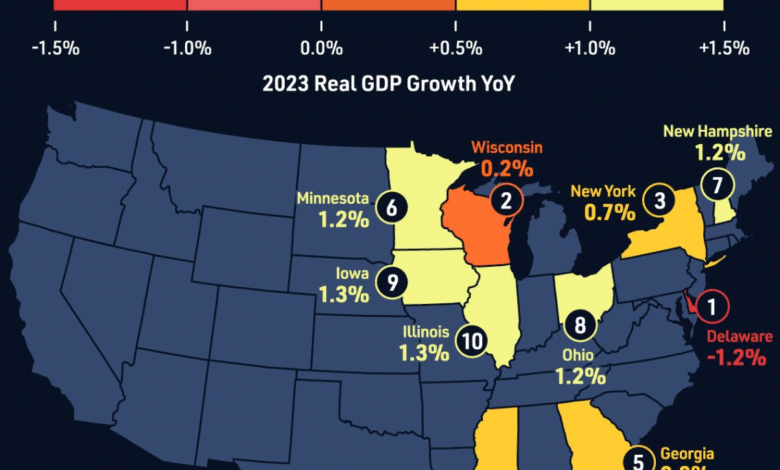Weakest State Economies at Risk in a Possible Recession

The weakest state economies in America reveal a troubling trend, as many are particularly vulnerable in the face of a potential recession. These states, marked by sluggish job growth and heavy reliance on federal funding, find themselves at risk of economic downturns that could have devastating impacts. Analyzing the recession impact on states, it becomes clear that those with weak fiscal structures are ill-prepared for financial challenges. As business leaders seek stability, the ongoing struggle of these vulnerable state economies becomes apparent; they grapple with fluctuating GDP and limited opportunities for growth. Understanding which states are at the bottom of the economic ladder is essential for businesses looking to invest in a safe and promising environment.
When examining America’s economic landscape, it’s critical to acknowledge the regions grappling with precarious financial states. These territories, often characterized as economically fragile, face substantial hurdles that could jeopardize their growth prospects. A recession poses significant threats to these areas, leading to concerns over their stability and capacity to attract new businesses. With many states wrestling with job creation, fiscal liabilities, and dependency on external funds, the potential for an economic crisis looms large. In this context, evaluating the overall health and sustainability of these unstable economies becomes crucial for understanding the broader implications for national growth.
Understanding the Weakest State Economies in 2025
In the current economic landscape, determining the weakest state economies in 2025 highlights vulnerabilities that resonate with potential uncertainties. As corporate leaders evaluate locations for business expansion, understanding which states are most at risk becomes imperative. Recent studies show that states with higher reliance on federal funding, like New Mexico and Mississippi, find themselves navigating treacherous grounds. As national economic conditions fluctuate, these states are likely to experience more pronounced effects from an economic downturn.
Moreover, states such as Alaska, heavily dependent on oil revenues, grapple with the volatility of global oil prices. The interconnectedness of state economies and national fiscal policy underscores how economic downturn risks can disproportionately impact specific regions. Thus, by identifying these weak state economies, stakeholders can strategize to mitigate risks and pursue more sustainable growth pathways.
Impact of Recession on Vulnerable State Economies
Across the United States, the looming threat of recession casts a shadow on several state economies. States at risk, like Oregon and Illinois, showcase how external factors like international trade and federal dependencies can exacerbate economic vulnerabilities. For instance, Oregon’s heavy reliance on trade makes it particularly susceptible should tariffs rise or trade relations sour, while Illinois continues to wrestle with significant credit and pension issues.
This volatileness in state economies can directly affect job growth and overall GDP figures, leading to an environment where businesses may hesitate to invest. As recession impacts deepen, states must be proactive in creating economic frameworks that promote stability and attract investment, particularly from corporate leaders wary of committing to regions with uncertain futures.
Economic Downturn and Job Growth Challenges
Job growth remains a crucial indicator of economic health, yet several of the weakest state economies exhibit concerning trends. For instance, West Virginia and Kansas are experiencing subdued job growth rates attributed to sectoral challenges that hinder robust employment opportunities. Federal job cuts and declines in agricultural viability create significant hindrances, limiting the prospect of recovery.
Furthermore, the performance of state economies in job creation remains pivotal not only for maintaining current employment levels but also for fostering new investments. By tracking job growth statistics, states can assess their economic performance relative to their peers and identify areas needing improvement, ensuring they remain competitive to attract businesses even amid potential downturns.
Identifying the Top States for Business Amid Weak Economies
While many states face economic challenges, the quest for corporate investments remains competitive. States that effectively market their fiscal stability and growth potential can stand out as attractive business hubs. For example, despite being on the list of weakest economies, regions like Alaska are working to highlight the resilience in certain sectors, such as sustainable resource management and tourism, to lure businesses looking for long-term operations.
By focusing on creating a favorable business climate, states can begin to transform their economic narratives. Initiatives that enhance infrastructure, stabilize fiscal policies, and promote local entrepreneurship can shift perceptions, allowing them to emerge stronger even in times of heightened economic risks.
Federal Dependency: A Double-Edged Sword for State Economies
The relationship between state economies and federal support has never been more critical. States like Louisiana and New Mexico illustrate how heavy reliance on federal funding can accelerate economic risks, especially when budget cuts loom. Federal dependency may provide short-term stability but can create long-term vulnerabilities, exposing states during economic downturns.
With the federal government’s spending habits directly influencing state budgets, leaders must reassess their economic strategies. Diversifying revenue sources, fostering local businesses, and reducing reliance on federal funds are essential steps for these vulnerable economies to build resilience against external shocks and the impacts of future recessions.
The Role of Infrastructure in Supporting Weak Economies
Infrastructure remains a significant factor impacting state economies, particularly for those ranked among the weakest. A lack of sufficient infrastructure can stymie economic growth, deter potential employers, and impede job creation. For instance, states like Rhode Island, despite having solid economic growth, face challenges due to inadequate infrastructure investment.
Developing robust infrastructure not only attracts businesses but also enhances the quality of life for residents, creating a more vibrant local economy. Investments in transportation, digital networks, and utilities are pivotal for states seeking to strengthen their economic positions and reduce vulnerabilities linked to economic downturns.
Strategies for Resilience in Vulnerable Economies
To navigate the uncertainties of a changing economic landscape, states need to develop comprehensive strategies that bolster resilience. This includes investing in economic diversification initiatives that can help mitigate risks associated with downturns. For example, Kansas might benefit from shifting focus in agriculture toward sustainable practices while boosting technology sectors.
Moreover, enhancing workforce development programs can empower residents with the skills necessary for emerging industries, ensuring job creation does not falter. States should prioritize building adaptive economies capable of withstanding the pressures of potential recessions, making them attractive destinations for future investments.
Policy Recommendations for Strengthening State Economies
Effective policy measures are vital in revitalizing the weakest state economies. Policies focusing on incentivizing small businesses, improving access to capital, and streamlining regulations can create more conducive environments for economic growth. For instance, Mississippi could enhance its business climate by revisiting tax structures to support local enterprises.
Additionally, fostering partnerships between public officials and business leaders can lead to targeted improvements in infrastructure and economic planning. Engaging stakeholders in conversations about future economic strategies can build a unified vision for growth, crafting pathways towards stability and reducing vulnerabilities during economic downturns.
Monitoring Trends and Forecasts in State Economies
Understanding the trajectory of state economies requires ongoing monitoring and analysis. Regular assessments of economic indicators, such as GDP growth rates and job creation statistics, help states adapt to changing economic conditions effectively. This vigilance is essential for identifying early warning signs of economic distress and allowing proactive measures to counteract impending downturns.
Moreover, engaging with economic experts and utilizing advanced analytical tools can empower state leaders to craft informed policies and adaptive economic strategies. By staying ahead of trends and forecasts, states can work collaboratively to strengthen their economies, ultimately enhancing their resilience and reducing risks during challenging times.
The Future Outlook for America’s Weakest State Economies
While the current landscape presents numerous challenges for the weakest state economies in America, there is also an opportunity for renewal. By embracing innovative strategies and focusing on sustainable growth, states like Alaska and West Virginia can transform their economic vulnerabilities into strengths. The commitment to fortifying local economies against external shocks is paramount.
As states navigate through these complexities, it will be critical to foster collaboration among local businesses, government agencies, and educational institutions. Frictionless communication and shared objectives can pave the way for proactive measures that not only protect against recession impacts but also enhance overall economic health, positioning these states for future prosperity.
Frequently Asked Questions
Which states are considered the weakest state economies at risk during a recession?
According to recent analysis, the ten weakest state economies most at risk in a recession include Oregon, West Virginia, North Dakota, Illinois, Rhode Island, New Mexico, Louisiana, Kansas, Mississippi, and Alaska. These states exhibit vulnerabilities due to various factors such as reliance on federal funding, slow job growth, and economic downturn risks.
What are the main challenges faced by vulnerable state economies like Louisiana and Mississippi?
Vulnerable state economies like Louisiana and Mississippi face significant challenges primarily due to their heavy reliance on federal funding, which represents about 50% of their budgets. Economic downturn risks that arise from potential budget cuts can severely impact their economic stability and job growth.
How do economic downturn risks affect job growth in states like New Mexico and West Virginia?
Economic downturn risks in states like New Mexico and West Virginia can lead to stagnation or reduction in job growth. For instance, New Mexico’s dependence on federal funding can result in decreased government jobs during federal budget cuts, while West Virginia’s shrinking workforce and federal job cuts pose serious obstacles to economic expansion.
In what ways do state economies at risk struggle to attract businesses?
State economies at risk, such as those among the weakest state economies, often struggle to attract businesses due to economic instability and weak growth indicators. Factors like low foreign investment, high unemployment rates, and significant debt burdens lead corporate leaders to view these states as less favorable for expansion and investment.
What role does federal funding play in the economic stability of states like Alaska and New Mexico?
Federal funding plays a crucial role in the economic stability of states like Alaska and New Mexico. For Alaska, where the economy is tied to oil prices and federal government jobs, fluctuations in federal spending can lead to severe economic setbacks. Similarly, New Mexico’s heavy reliance on federal funding for its budget makes it vulnerable to economic downturns and budget cuts.
How does Illinois compare to other weak state economies in terms of economic health?
Illinois, despite being among the weakest state economies, maintains a substantial presence of S&P 500 companies and attracts considerable foreign investment. However, it faces significant challenges with unfunded pension liabilities and one of the lowest credit ratings in the U.S., impacting its overall economic health.
What insights can be drawn about the top states for business in relation to weak state economies?
Insights from the top states for business suggest that a strong, stable economy is critical for attracting investments. This contrasts sharply with weak state economies, which often highlight vulnerabilities such as fiscal instability and labor market challenges, making them less appealing for corporate site selectors.
Why are the weakest state economies critical to consider when analyzing potential recessions?
The weakest state economies are critical to consider when analyzing potential recessions because they serve as indicators of broader economic vulnerabilities. States prone to recession often reflect systemic issues that can exacerbate national economic downturns, making it essential for policymakers and business leaders to understand these dynamics.
| Rank | State | GDP (2024) | Job Growth (2024) | Key Risks |
|---|---|---|---|---|
| 10 | Oregon | $265.1 billion (+1.2%) | 0.6% | Heavy reliance on international trade, especially with China. |
| 9 | West Virginia | $83.7 billion (+3.5%) | 0.2% | Shrinking workforce and federal job cuts. |
| 8 | North Dakota | $59.9 billion (–0.7%) | 1.5% | Economic contraction while national GDP grows. |
| 7 | Illinois | $895.3 billion (+1.1%) | 0.7% | Significant unfunded pension liabilities and poor credit rating. |
| 6 | Rhode Island | $65.3 billion (+3.2%) | 1.1% | Low foreign direct investment and heavy reliance on federal funding. |
| 5 | New Mexico | $112.8 billion (+2.2%) | 1.1% | High dependency on federal funding and low business survival rates. |
| 4 | Louisiana | $256.4 billion (+3.1%) | 1% | 50% reliance on federal funding and some international trade. |
| 3 | Kansas | $185.7 billion (+1%) | 0.7% | Challenges in agriculture affecting broader economy. |
| 2 | Mississippi | $122.4 billion (+2.4%) | 1.3% | Near 50% federal funding dependency poses risks. |
| 1 | Alaska | $54.9 billion (+1.5%) | 2.7% | Heavy reliance on oil prices and federal government jobs. |
Summary
The weakest state economies in the United States face significant challenges that make them particularly vulnerable to recession. With ongoing concerns over federal funding, dependency on international trade, and structural issues like unfunded liabilities, these states need to adopt proactive measures to strengthen their economic foundations. Careful attention to job growth, fiscal stability, and economic diversification will be essential for their resilience against future downturns.




